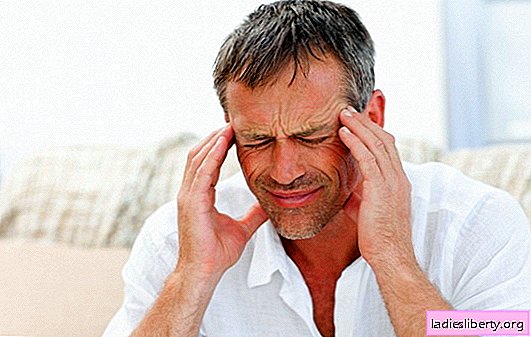
The brain is responsible for the regulation of almost all processes and reactions in the body.
In order to fulfill its direct duties in a quality manner, this the commander in chief needs good nutrition.
The numerous vessels that pierce all body tissues carry out oxygen delivery.
Blood flow occurs due to stable contractions and relaxation of the walls of blood vessels.
Under the influence of a number of factors, the tone of the walls of the vessels can change, causing a spasm.
In this case, blood flow is disturbed, which leads to severe pain syndrome.
How are cerebrovascular spasms manifested?
With spasm of the vessels of the brain, a sharp narrowing of the lumen occurs, which provokes oxygen deficiency. The brain cells, lacking oxygen, react with malfunctions in the functioning of the nervous system. Vascular crisis can be a harbinger of quite dangerous pathologies.
The clinical picture of the pathology depends on the size of the vessels in which the spasm occurred, the location of the process and the duration of the spasm.
With cerebral spasm, neurological symptoms are observed, which is inherent in the part of the brain that has not received due to spasm of the proper amount of oxygen.
A characteristic and predominant sign of vascular spasm in the brain are headaches of various locations and intensities.
So, for hypertensive patients and patients with VVD, the location of pain in the temples, nape, and forehead is characteristic.
Angiospasm provoked by a sleepless night, a sharp decrease in pressure, a change in weather conditions, is manifested by pain in the morning or due to sharp bends.
Often, headaches that begin in a particular area can span over larger areas, be reborn, or be accompanied by feelings of heaviness, contraction, or pressure.
Vasospasm, depending on the causes and location of the pathology location, may be accompanied by other negative symptoms:
• redistribution of pain in the eye or neck;
• unpleasant numbness, tingling lips, temples;
• dizziness with fainting;
• blanching of the face;
• darkening in the eyes;
• change in heart rate;
• uncomfortable sensations in the head, aggravated by coughing, sneezing;
• sudden sweating;
• tinnitus;
• nausea;
• the appearance of "flies in the eyes";
• high fatigue;
• low working capacity;
• memory problems.
If a vasospasm in the brain occurs as a precursor to stroke or signs of aneurysm rupture in a patient may be observed in the form of:
• speech impairment;
• hearing problems;
• difficulties with the motor abilities of the limbs;
• loss of consciousness;
• vomiting;
• paralysis of part of the face.
The insidiousness of the disease lies in the masking of symptoms.
Vascular spasm is easy to confuse:
• with arterial stenosis with a thrombus or atherosclerotic plaque, causing an ischemic type of stroke;
• with hemorrhage in the brain;
• tumors of various quality.
At the same time, with prolonged oxygen starvation of brain tissue caused by vascular spasm, the likelihood of developing a stroke is high.
For children with chronic spasms of blood vessels in the head, the appearance of complications is characteristic:
• developmental delays;
• hearing pathologies;
• vision problems;
• various neurological disorders;
• paresis;
• persistent migraine attacks.
Causes of cerebrovascular spasms
In fact, spasm is associated with a decrease in the elasticity and tone of the vessel walls. A similar condition can arise for completely different reasons related to health and behavioral factors.
Vascular spasm can be triggered by:
• Cervical osteochondrosis. Dystrophic processes affecting the cartilage and bone tissue affect the size of the vascular channels. When blood vessels are compressed, blood flow is difficult, which contributes to spasm.
• Aneurysm with pathological protrusion or thinning of the walls of blood vessels.
• Renal and cardiac ailments.
• Thyroid problems.
• Vegetative-vascular dystonia, one of the manifestations of which is vasospasm.
• Unstable blood pressure. Spasm can occur both with an increase and a decrease in pressure indicators.
• Defects in muscle tissue of blood vessels, contributing to a weakening of the tone.
• Pathological formations in the brain in the form of tumors, cysts.
Indirect provocateurs of vasospasm in the brain can be behavioral factors in the form of:
Overwork. With intensive labor or physical activity, not involving interruptions, the probability of a deterioration in blood flow is high, which often leads to spasms. Patients are often confronted with spasm, spending a lot of time without changing the position of the body, working at a computer or in stuffy rooms.
Lack of sleep. Lack of rest affects the physiological abilities of the brain and blood vessels. Continuous functioning weakens protective abilities and leads to general overwork and cramping.
Oxygen deficiency. Oddly enough, you can get rid of spasms regularly while outdoors and ventilating the room. The body, lacking in the much-needed oxygen, can react with spasms of blood vessels.
Nervous Overexcitation. Negative emotions provoke the release of a huge amount of stress hormones into the blood, which, in turn, leads to physiological changes in the body, including problems with blood vessels.
Domestic situations in the form of hypothermia of the head, alcohol, trouble at work and even positive emotional reactions can also cause vascular spasms in the brain.
A special group can include meteorological people. Such patients are sensitive to any changes in the weather, especially the pressure drops affect their well-being.
At risk also include patients with:
• metabolic problems;
• hereditary predisposition to strokes, heart attacks;
• hypertension or angina pectoris;
• tendency to form blood clots;
• a history of inflammatory or infectious brain pathologies.
Brain cramps are a common occurrence in alcoholics, smokers, lovers of uncontrolled treatment with medications, and in patients who have extra pounds.
Diagnosis of possible diseases with vascular spasm in the brain
They deal with vascular problems, including spasms in the brain neurologists or angiosurgeons.
It is almost impossible to determine the true cause of spasms without examinations based on the results of a patient survey. The doctor will need at the initial stage of the examination control over the pressure indicators, the study of the vessels of the eyeball, laboratory examinations of blood parameters.
With further diagnosis, usually resort:
• To duplex scanning of arteries. Such an ultrasound examination helps to determine the pathology of the structure of blood vessels, detect blood clots and plaques, and analyze the speed of vascular blood flow.
• To magnetic resonance or computed tomography. The study is carried out using contrasting modes, which helps to diagnose various disorders associated with blood vessels.
• X-ray examinations if MRI is not acceptable.
If necessary, the doctor can refer the patient for further examination and consultation with an otolaryngologist, cardiologist, endocrinologist.
How to treat spasms of blood vessels in the brain?
The treatment of vascular spasms is a rather lengthy process and requires discipline and patience from patients. Many pathologies associated with spasms are chronic. Therefore, effective therapy is impossible without changing habits, lifestyle and adherence to prevention recommendations.
How to quickly eliminate the negative symptoms of vascular spasm?
If you have a cramp before visiting a doctor, you can try to calm the pain yourself.
To cope with the symptoms of spasm will help:
• Foot cold baths.
• Washing with ice water.
• Taking a horizontal position.
• Tablets: Aspirin, Spazgan, Ibuprofen, Nurofen.
• Drops of corvalol or valerian.
• Drunk warm water with honey.
• Self-massage of temples, neck.
If there is prolonged pain that is not amenable to relief with tablets and other methods, it is urgent to seek medical help.
Drug therapy
The course of drug therapy is selected by doctors based on the cause of the pathology. Depending on the individual reactions to therapy, repeated correction of treatment may be carried out.
To eliminate spasms, calcium antagonists are most often used. The dosage of Adalat, Phenigidin, Corinfar, Telektol is selected by doctors only individually.
To get rid of the pain, they resort to intravenous administration of Papaverine, Eufilin, Revalgin, Papazol, No-shpa.
To remove emotional stress, anxiety, stressful conditions, sedatives in the form of motherwort, valerian help. In severe cases, tranquilizers such as Relanium, Seduxen or antidepressants in the form of Amitrirtillin, Azafen can be prescribed.
With vascular pathologies, they often resort to the use of nootropics. Intravenous administration of Piracetam, Nootropil, Trental is provided. It is also allowed to take such drugs in the form of tablets.
Vascular preparations in the form of Cavinton, Stugeron, Cerebrolysin, Actovegen, Vinpocetine help in the treatment of spasms.
For the general strengthening of the body, adaptogens such as ginseng, eleutherococcus, lemongrass, pantocrine, and aralia are prescribed.
Drug therapy It is advisable to supplement with auxiliary methods of healing:
• massage by courses;
• electrophoresis;
• darsonvalization;
• hydrotherapy;
• balneotherapy.
• medical gymnastics;
• acupuncture treatment.
Home treatment
In the piggy bank of folk methods, there are a considerable number of recipes and methods for eliminating vasospasm. The following home therapy recipes have proven themselves well:
• You can make a healing broth from valerian, motherwort, yarrow and anise. Take a similar broth instead of tea directly during a spasm.
• An ice compress will help cope with spasm, for which it is necessary to prepare a decoction. For a healing broth, they take plantain, St. John's wort and dandelion, which are poured with boiling water and allowed to infuse.
• For medicinal purposes, take about two months before each meal, a decoction made from thyme with garlic.
Essential oils with soothing properties also help cope with cramping. For aromatherapy, you can use jasmine or lavender.
Do not forget about disease prevention measures. Healthy sleep, rational exercise, a balanced diet help prevent spasms without pills.











